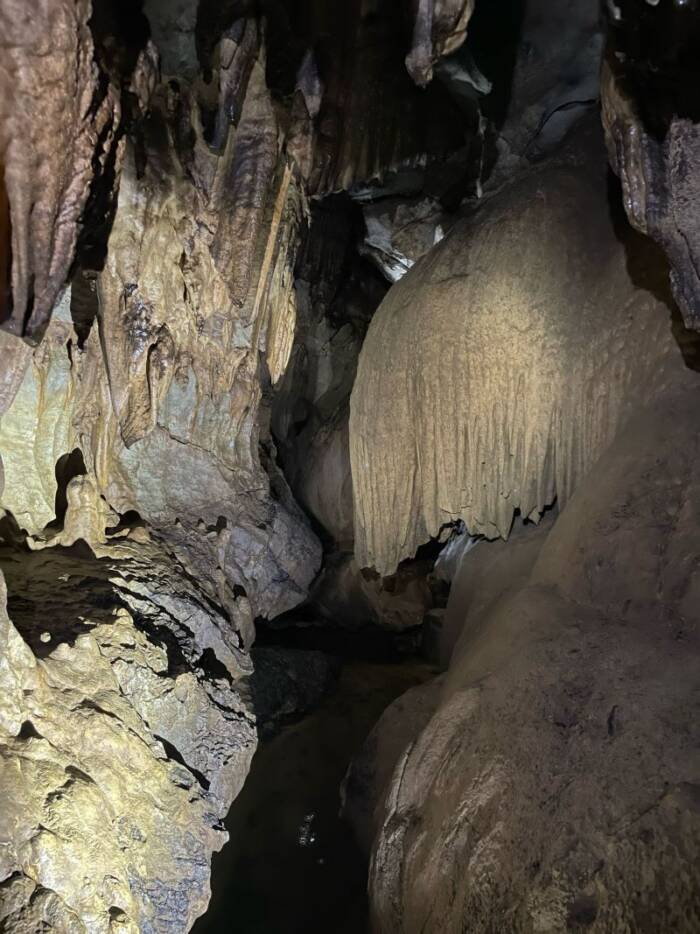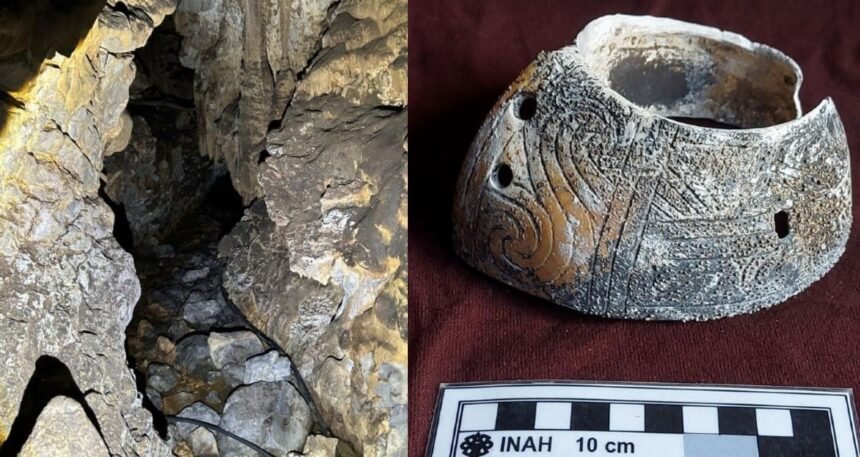Believed to have been used in fertility rituals by the Tlacotepehua people sometime during the Postclassic Period that spanned 950 to 1520 C.E., these artifacts included perforated snail shells, stone disks, and a collection of bracelets that had been wrapped around the cave’s stalagmites centuries ago, just “like a ring on a finger.”
Miguel Pérez/National Institute of Anthropology and HistoryArchaeologists believe that the objects date from the Postclassic Period (950 to 1521 C.E.).
In 2023, a spelunker and her guide set out to explore a Mexican cave that’s believed to have gone untouched for 500 years. Deep inside this subterranean expanse, they eventually came across a number of objects that initially appeared to be trash — but were actually centuries-old artifacts from the little-understood Tlacotepehua culture.
These 14 objects, including three engraved shell bracelets, are a fascinating collection of rare relics, made all the more interesting due to the fact that archaeologists believe they may have been left inside the cave on purpose as part of a fertility ritual hundreds of years ago.
The “Exciting And Incredible” Discovery Of Centuries-Old Relics Inside Mexico’s Tlayócoc Cave

Katiya Pavlova/National Institute of Anthropology and HistoryA portion of the vast interior of Tlayócoc cave.
According to a statement from the National Institute of Anthropology and History (INAH), the objects were found at Tlayócoc Cave by Russian speleologist Yekaterina Katiya Pavlova and her guide Adrián Beltrán Dimas. It’s likely that no one had ventured deeply into the cave for 500 years, though locals use it as a resource for water and bat guano for their gardens.
Dimas and Pavlova, who has been exploring and mapping caves for six years, trekked far into the cave, navigating through narrow passageways and pools of water. While taking a break at one point, they suddenly noticed a collection of objects nearby — which, initially, Pavlova angrily dismissed as trash that had just recently been thrown there by someone.
Then Pavlova realized that she and Dimas had stumbled upon something much more spectacular: a collection of 14 artifacts that had seemingly been left in the cave some 500 years ago.
“It was very exciting and incredible,” she said. “[W]e were lucky here.”

Katiya Pavlova/National Institute of Anthropology and HistoryOne of the centuries-old objects that was recently uncovered inside Tlayócoc Cave.
After photographing the objects, Pavlova and Dimas contacted the National Institute of Anthropology and History to take a closer look at the site.
The 14 Artifacts Found In Tlayócoc Cave And How They May Have Once Been Used
Archaeologists, alongside a local historian, made the long trek to Tlayócoc Cave to examine the objects that Pavlova and Dimas had discovered.

Guillermina Valente/National Institute of Anthropology and HistoryThe phallic nature of the stalagmites in the cave suggest that the area may have once been used to conduct fertility rituals.
There were 14 objects recovered from the cave in all: three bracelets, possibly made from conch shells, a fragment of a bracelet made from a mollusk shell, a sea snail shell with perforations and decorations, a piece of carbonized wood, two complete stone discs, similar to pyrite (“fool’s gold”) mirrors, and six more fragments of discs, as well as sediment samples.
Iconography on the three bracelets seems to show the “representation of beads” as well as a symbol known as “xonecuilli.” In the Nahuatl language, this means “crooked foot,” and is associated with the planet Venus. Another figure on the bracelets appears to be Quetzalcoatl or Tlahuizcalpantecuhtli, deities associated with the “morning star” and seashells.

Miguel Pérez/National Institute of Anthropology and HistoryThe “s-shaped” symbol on one of the bracelets, which means “crooked foot” in the Nahuatl language and is associated with the planet Venus.
These motifs are similar to what’s been found at other archaeological sites in the area. Archaeologists believe that these new discoveries likely date back to between 950 and 1521 C.E., and that they’re probably linked to the Tlacotepehua people that once inhabited the region. Some 500 years ago, archaeologists suspect that the Tlacotepehua used the cave, its phallic stalagmites, and these objects to conduct some kind of fertility ritual.
“For pre-Hispanic cultures, caves were sacred places, associated with the underworld and considered the womb of the Earth,” INAH archaeologist Miguel Pérez Negrete explained. “There is a symbolic integration at the site, since, according to Mesoamerican myth, Quetzalcoatl was a deity who extracted, from the depths of the planet, the corn and bones from which humanity was formed and, through their sacrifice, gave rise to life, the knowledge of agriculture, and fertility.”
However, little is known about the Tlacotepehua culture, which vanished during the Spanish occupation. As such, the objects found in Tlayócoc Cave are especially significant, and sheds rare light on this mysterious civilization.
After reading about the collection of 500-year-old objects found by spelunkers inside a cave in Mexico, discover the eerie story of Mexico’s Guanajuato mummies, 111 mummified human remains whose faces seem to be eternally locked in an expression of agony. Then, read about Templo Mayor, the Aztecs’ main temple which they believed was the center of the universe.











